2 Insect Phylogeny and Classification
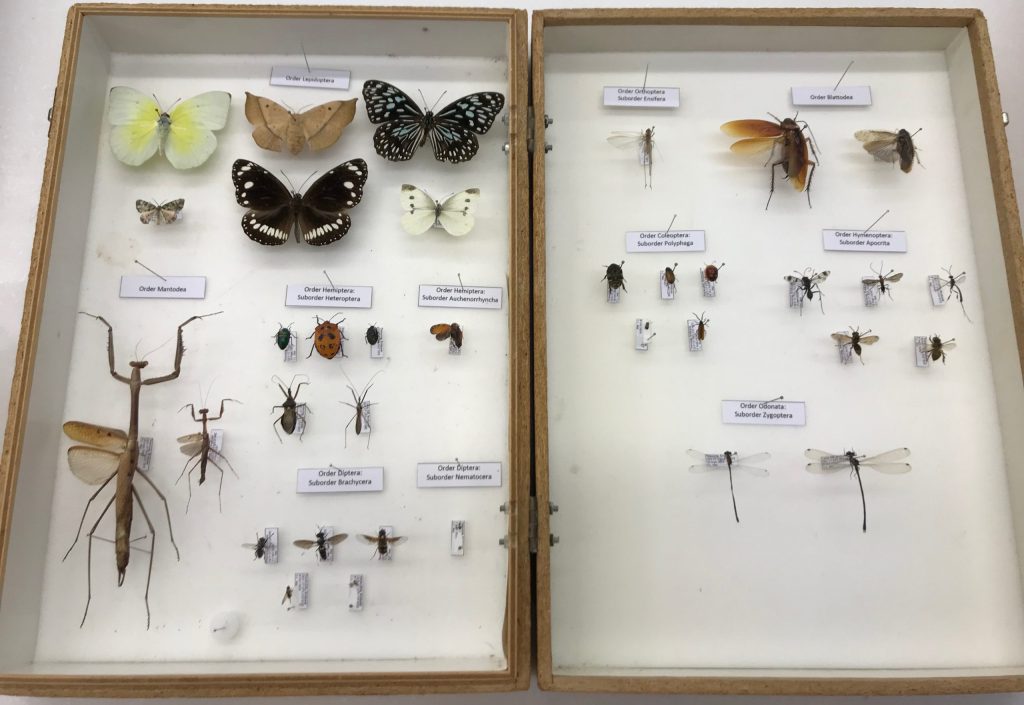
In this chapter, we become familiar with the naming system for insects and explore the evolutionary relationships of the orders of insects. Because insects are so widespread, many species have not yet been named and identified: insects are the majority of new species being named and published in journals such as Zootaxa. The classification system for insects is not completely settled, even at the level of Orders. Application and refinement of DNA sequence-based studies, along with new discoveries has prompted recent re-evaluations of the accepted taxonomy.
Learning Objectives
- Understand the Linnean approach to classifying insects
- Be able to explain the binomial system of naming animals
- Know the members of the Superclass Hexapoda
- Identify characters that distinguish the major subdivisions of the Hexapoda
Phylogeny and Classification
Before we discuss the characteristics of the major insect groups, we need to consider how insects are classified and named in order to gain an understanding of the terminology used by taxonomists and to appreciate the international codes governing the process of naming animals, including insects.
Important terms
Taxonomy and systematics are terms that are often confused.
- Systematics is the study of the diversity of organisms and how they are inter-related. It has two components: taxonomy and phylogenetics.
- Taxonomy is the science and practice of classifying organisms. It involves recognising, describing and naming species, and classifying them into a ranked and named system.
- Phylogenetics is the study of the evolutionary relatedness of organisms. It provides information useful for constructing an evolutionary (“natural”) classification system, for understanding the evolution of traits, and for understanding how and why organisms are distributed as they are.
Humans like to name and categorise things, and are typically good at using small differences to distinguish among categories. Think of everyday groupings such as cups, mugs, chairs and plates. There can be lot of variety in each of these, but most of the time we can easily differentiate between them, even a cup and a mug.
Current classifications of insects (and other animals) are based on a combination of ideas for how to recognise the rank and relationships of groups, with most orders being based on groups (taxa) with distinctive morphology. Other data, such as DNA sequences, and behavioural, ecological and physiological characters, are also used by taxonomists (scientists who recognise, describe, name and classify organisms). Taxonomists group similar individuals into species, and similar species are grouped into genera, genera are grouped into families etc. Thus, the classification system for organisms is hierarchical, with classification levels nested one inside the other.
In summary, the hierarchy of major classification levels for animals, including insects, from more inclusive groups down to less inclusive groups is shown in the following table.
The practice of modern taxonomy was developed by the Swedish biologist Carolus Linnaeus in the late 1700’s. The rules proposed by him still form the basis for modern taxonomy. Linnaeus proposed that all species should have a double name, which is called a scientific binomen, and the use of binomial nomenclature is still generally adopted and standardised globally. Recommendations for naming and classifying animals are outlined in “The International Code of Zoological Nomenclature” (ICZN), which is administered by the International Commission on Zoological Nomenclature.
The ICZN code “regulates” (it can really only recommend because there is no international “law”) names in the species, genus and other major classification levels up to Superfamily. The standard use of a binomen for each species allows people everywhere in the world to communicate with little confusion over which species is being discussed.
| All animals | Insects |
|---|---|
| Kingdom | Animalia |
| Phylum | Arthropoda |
| Class | Insecta |
| Order | 27 Orders |
| Family | 1000s of families |
| Genus | many 1000’s of genera (plural of genus) |
| Species | more than 1.5 million described species |
Scientific binomens are typically in Latin or latinised Greek roots and are unique to an organism under the code; no species of animal can have the same name as another. However, because plants and animals have different codes, an insect might have the same name as a plant. Examples of genus names shared across codes are:
Agathis: a coniferous plant and also a parasitic wasp
Kingia: a grass tree and a mosquito
The scientific binomen of an organism provides the key to finding information in the scientific literature. The scientific binomen for a species is the same no matter what country the species occurs. On the other hand, a common name for a particular species may vary from country to country. Care should be taken in referring to a species by a common name for this reason.
The scientific name of the beautiful iridescent Botany Bay weevil might also be written as Chrysolopus spectabilis (Fabricius, 1775). This indicates that the person who first described this species had the family name (surname) of Fabricius and he described the species in 1775. Sometimes a taxonomist later studies the same species and its relatives and might decide that the species belongs in a different genus. In this case, the original describer’s (author’s) name is placed in parentheses.
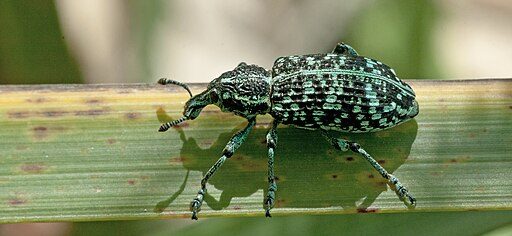
So, Chrysolopus spectabilis (Fabricius) is now in a different genus from that in which Fabricius first described it; we know this because Fabricius is in parentheses. When an insect species is recognised for the first time and a new scientific name published, the Code specifies that it be accompanied by a description of the appropriate life stages (almost always including the adult) in sufficient detail that the species can be distinguished from its close relatives. Features diagnostic of the newly recognised species must be explained and any variations in appearance or habits described or discussed.
Keen to know more?
If you want to know more about how species are described, you can read about some newly described species in the open access Australian Journal of Taxonomy:
A summary of the classification hierarchy, and the levels that are regulated by the ICZN Code, are indicated in the table below. The classification of the Botany Bay weevil is used as an example for each category.
| Classification Level | ICZN Code | Example |
|---|---|---|
| Phylum | Arthropoda | |
| Class | Insecta | |
| Infraclass | Pterygota | |
| Order | Coleoptera | |
| Suborder | Polyphaga | |
| Superfamily | names end in ‘oidea‘ | Curculionoidea |
| Family | names in in ‘idae‘ | Curculionidae |
| Subfamily | names end in ‘inae‘ | Aterpinae |
| Tribe | names end in ‘ini‘ | |
| Genus | names begin with a capital letter and are italicised | Chrysolopus |
| Species | names are binomial; they contain a genus name AND a species epithet that begins with a small letter and italicised | Chrysolopus spectabilis |
The implementation and upholding of the ICZN Code is mostly done via peer review – if an author has not followed the ICZN Code, a manuscript might not be accepted by reviewers or editors until the it is followed. However, the Code is not an enforceable law and alternative systems have been proposed. One of these – PhyloCode – has been adopted by some authors and their peers, but it is not as universally accepted as the ICZN Code. PhyloCode has mainly been applied at classification levels above species.
The biological classification of the insects is an on-going process, with many hundreds of thousands of species still undescribed and waiting to be classified. Agreement on classifications is often difficult to achieve because of the great diversity of morphology and because molecular data do not resolve all relationships. As more data become available, classifications can, and do, change. Even the number of insect orders remains debatable, even though most orders are reasonably well-defined by morphological characters. We are presenting 28 orders of insects. Recent changes include the incorporation of termites into Blattodea, fleas into Mecoptera, and grouping parasitic, chewing and bark lice into Psocodea. For this text, we have examined the fleas (Siphonaptera) and hanging flies (Mecoptera) separately.
| Insect Order | Common name/s |
|---|---|
| Archaeognatha | bristletails |
| Zygentoma | silverfish |
| Ephemeroptera | mayflies |
| Odonata | dragonflies, damselflies |
| Plecoptera | stone flies |
| Dermaptera | earwigs |
| Zoraptera | zorapterans |
| Orthoptera | grasshoppers, crickets, katydids |
| Embioptera | web spinners |
| Phasmatodea | stick & leaf insects, phasmids, walking sticks |
| Grylloblattodea | ice walkers, rock crawlers |
| Mantophasmatodea | heel walkers |
| Mantodea | praying mantis, mantids |
| Blattodea | cockroaches, termites |
| Psocodea | bark lice, chewing lice, sucking lice |
| Thysanoptera | thrips |
| Hemiptera | bugs, cicadas, leafhoppers |
| Raphidioptera | snakeflies |
| Megaloptera | alderflies, dobsonflies, fishflies |
| Neuroptera | lacewings, antlions |
| Coleoptera | beetles, weevils |
| Strepsiptera | strepsipterans |
| Diptera | flies |
| Mecoptera | scorpionflies, hanging flies, snow fleas |
| Siphonaptera | fleas |
| Trichoptera | caddisflies |
| Lepidoptera | moths, butterflies |
| Hymenoptera | ants, bees, wasps, sawflies, wood wasps |
Phylum Arthropoda
(arthro = joint, poda = foot)
Insects belong to the phylum Arthropoda – the joint-legged animals. To understand the evolution of insects, it is helpful to have an overview of the evolution of arthropods in general. As a good introduction to this topic, watch “The arthropod story” from UC Berkeley. It takes you on a tour through the amazing evolutionary history of arthropods. Along the way, you’ll get a healthy dose of taxonomy, palaeontology, natural history and principles of evolution. You can be assessed on your knowledge of the story, particularly in relation to the topics mentioned in this course.
Traditionally, hexapods were thought to be most closely related to myriapods (millipedes and centipedes). Current evidence suggests that Crustacea are the closest relatives of Hexapoda. This latter relationship is supported by DNA sequences and developmental and morphological data, particularly those of the compound eye and nervous system. However, it is unclear whether the whole of Crustacea is sister to hexapods, or whether it is just the Malacostrata (crabs, crayfish etc), or just the Branchiopoda (fairy shrimps, tadpole shrimps and water fleas).
| Major subgroups of arthropods | common names |
|---|---|
| Chelicerata | spiders, mites, ticks, scorpions, etc. |
| Myriapoda | millipedes, centipedes |
| Crustacea | crabs, prawns, slaters, land shrimp, etc. |
| Hexapoda | arthropods with six legs (such as insects, springtails, |
Superclass Hexapoda
Hexapods can be classified according to different evolutionarily significant features, primarily the mouthparts and the wings.
Mouthparts
Entognathous: mandibles are concealed when not in use (Protura, Collembola and Diplura). There is some evidence that these three groups are each other’s closest relatives and the latest edition of Gullan & Cranston’s “The Insects” treats them as a Class called Entognatha. Together, they are sister to the insects.
Ectognathous: mandibles remain exposed and are not extensible (Insecta).
The relationships amongst the hexapods are shown in the phylograms below. Each taxon has been coded as to whether it has entognathous or ectognathous mouthparts (see legend; small box next to each taxon shows the state in that taxon). The origin of the insects is indicated with an arrow, indicating that all insects derived from that branch had wings as an ancestral state. Remember, though, that insects can often lose their wings as a secondary trait. The character reconstruction (coloured branches as per legend) shows that the ancestor to all insects had ectognathous mouthparts.
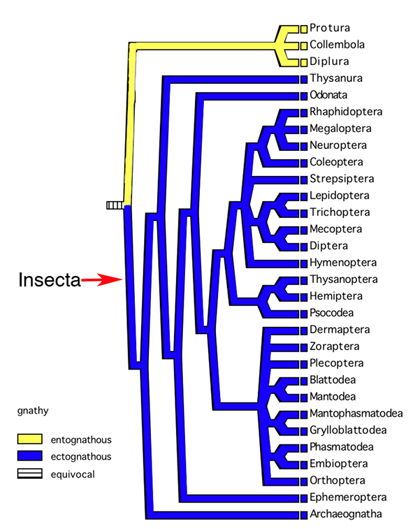
Wings
Two orders of insects are primitively wingless: Zygentoma (Thysanura) and Archaeognatha – their ancestors did not have wings. Wings evolved in the common ancestor of the pterygote insects. Pterygota (commonly treated as an infraclass) are the winged or secondarily wingless (apterous) insects, with thoracic segments of adults usually large and with the meso- and metathorax variably united to form a pterothorax. The sharing of a common origin of wings helps defines the Pterygota as a monophyletic (natural) group.
The pterygote insects can be further classified according to the mode of development of the wings. Most orders of pterygotes have wing buds that develop externally (exopterygous). This appears to be the ancestral state for pterygotes, and therefore does not help to define a group of insects. In contrast, some insects have wings and genitalia that are internalised in the pre-adult stages. This derived trait defines the group called Endopterygota. This group used to be called Holometabola because it was thought to be defined by holometabolous development, but similar development also occurs in some of the other insects.
exopterygous (= outside wings) – wing buds develop externally
endopterygous (= inside wings) – wings buds develop internally (Endopterygota)
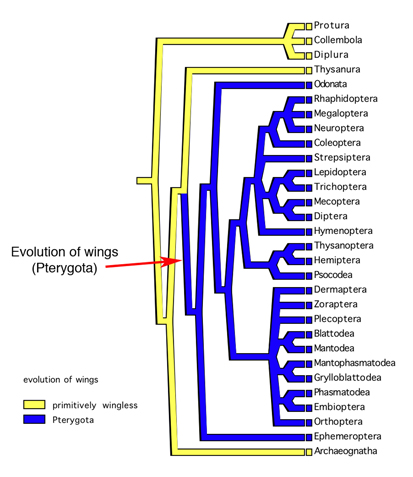
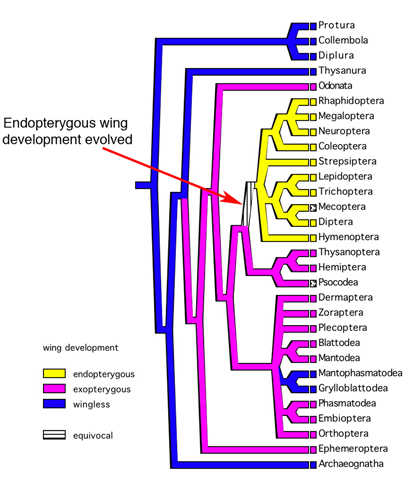
Topic Review
Do you know…?
- how insects are classified?
- the various levels of classification
- the common and scientific names of the major insect orders
- The logic applied to inferring ancestral states in the phylograms of insect evolution?
- Understand the logic by which phylogenetic trees are used to make inferences about ancestral states

